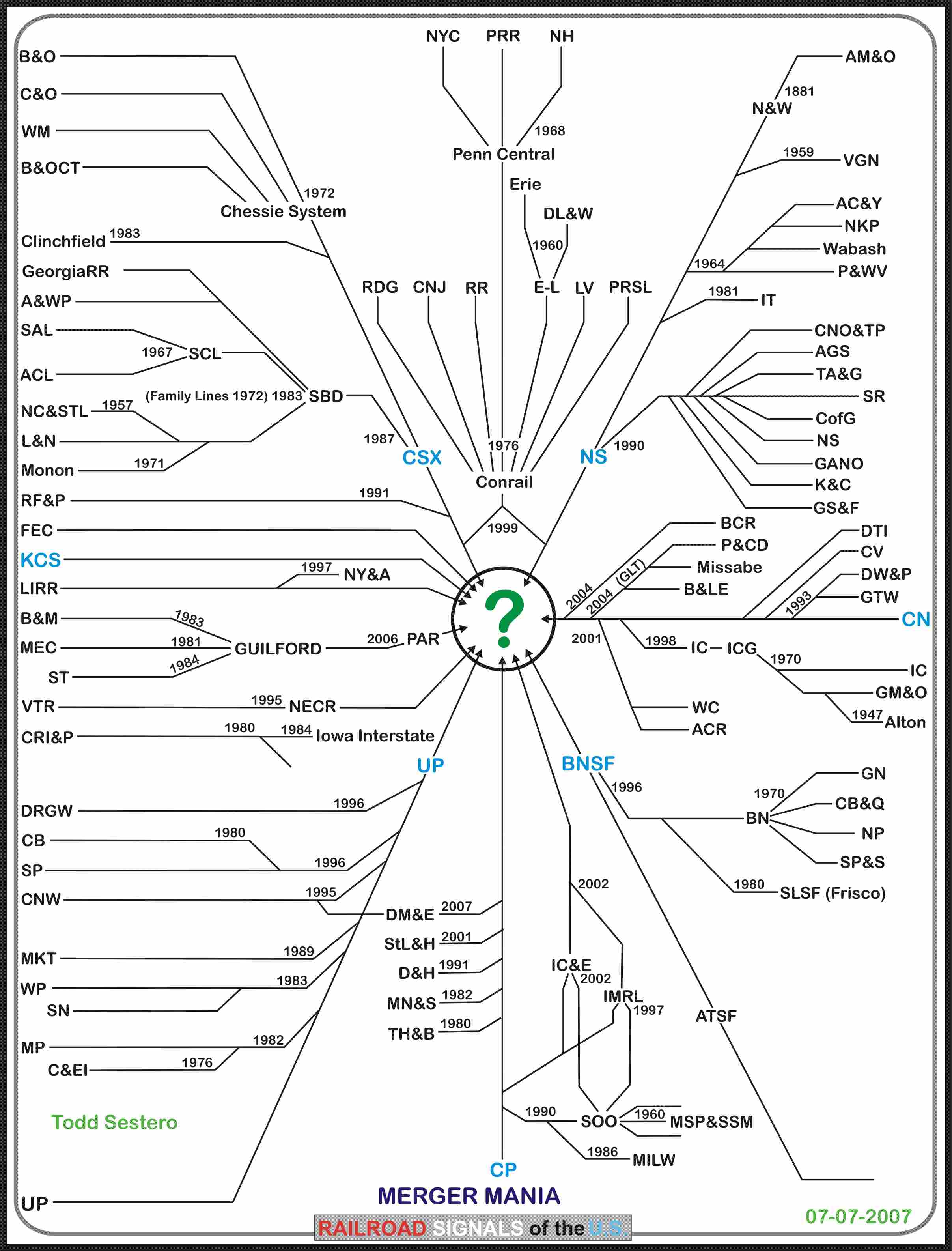A NB Northern Central train in Lutherville MD around 1918.
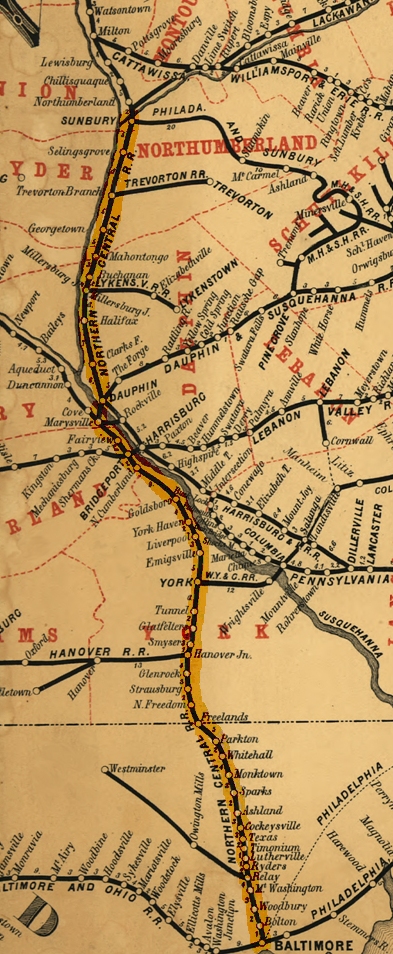
The Penn Central Railroad
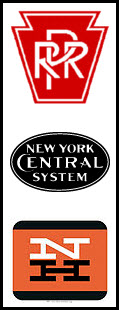

The only railroad in Maryland that
became part of the Penn Central railroad
system was the Pennsylvania RR. The
merger of the PRR, the
New York Central, and the
New Haven RR happened in 1968, and all freight and passenger
operations continued under the Penn Central
flag.
The Penn Central fumbled along with passenger service, losing money from the
beginning. Being that passenger service over most of the United States was in
poor shape, and losing money, Amtrak was
formed in 1971 and took over the Penn Central's passenger operation on the
Northeast corridor. The last passenger train between Baltimore and
Harrisburg via the Northern Central, a single E unit and a coach, was the day before Amtrak took over
on April 30th, 1971.
For a boatload of info, check
here

Amtrak

On May 1st, 1971, the federal government took
over the vast majority of passenger operations from railroads across the
country. This included the PRR/Penn Central's operation on the Northeast
Corridor between Washington DC and Boston. Passenger service on the B&O
was not included in this deal, probably because Amtrak considered it a
duplication of service. Amtrak today, is still obviously still going
strong, and the NEC is one of the few "lines" that pays for itself. They
continue to invest heavily in infrastructure by upgrading the track, the
overhead wire, and the signaling system.
For more info, look here
Maryland Department of Transportation
MARC - MAryland Rail Commuter
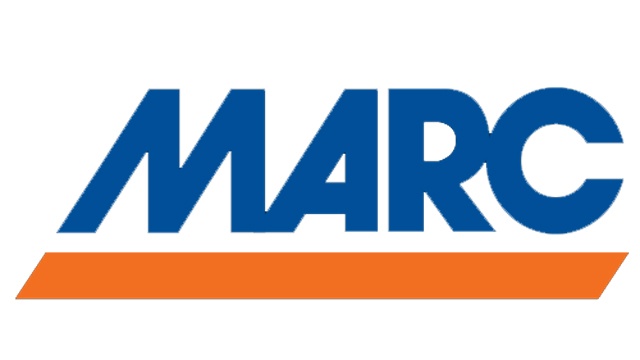

In 1974, Maryland's MDOT gave the
B&O a subsidy to help keep the Camden Line service alive. In 1975,
Maryland agreed to fund the entire operating deficit, and agreed to buy new
rolling stock. Maryland finally assumed all operations of the
commuter service in 1982, over the former B&O line between
Baltimore and Washington DC.
The MARC named arrived in 1983, after it assumed commuter operations from Conrail.
MARC is considered the fastest
commuter rail service in the United States, but only because the Penn Line operates on the
Northeast Corridor. Even though MARC bought a couple of the Acela type
engines, it still mostly runs diesels on the Penn Line.
 From Wikipedia, Jan 2008
From Wikipedia, Jan 2008

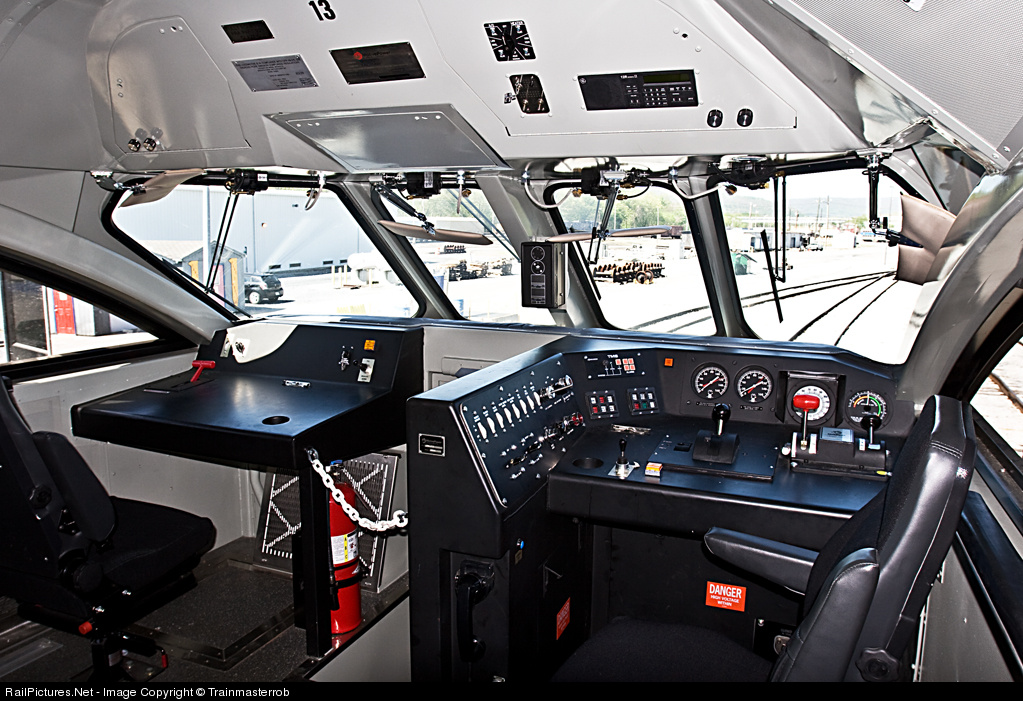 MP36PH-3C Cab
MP36PH-3C Cab
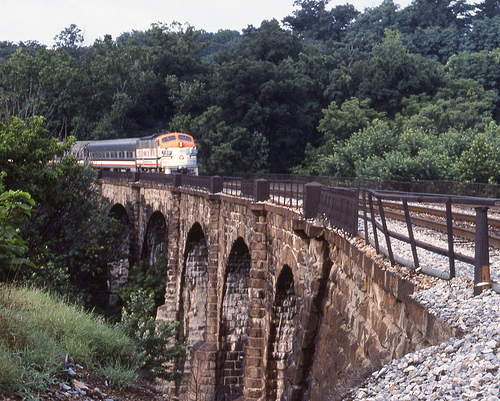 An earlier MDot train NB on the Thomas Viaduct
An earlier MDot train NB on the Thomas Viaduct
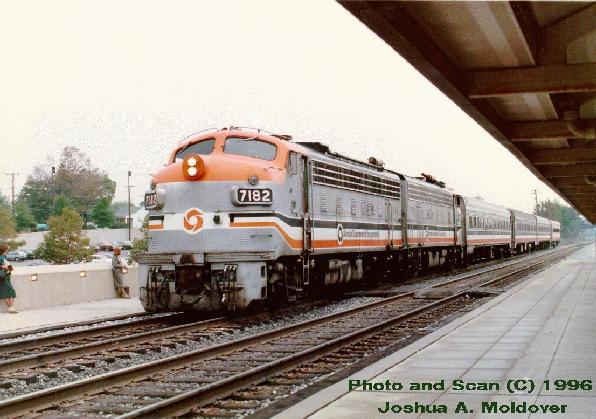
Conrail

Ahhhh, the railroad we all love to
hate. When the Penn Central, and most of the other Northeast railroads
started getting into financial trouble in the mid 1970's, the government's
solution was the formation of Conrail.
Conrail was incorporated on October 25th, 1974, and assumed operation of the
bankrupt railroads on April 1st, 1976. It took over the
Penn Central, the
Reading RR, the Central RR of New Jersey,
the Lehigh Valley RR, the
Pennsylvania-Reading Seashore Lines, the
Erie-Lackawanna, and the
Raritan River RR. Conrail itself, as
large as it was, felt the strain of a lackluster economy, and on June 1st, 1999,
was divided up into two parcels, with about 40% of it going to CSX, and 60% of
it going to Norfolk Southern. In areas where the government felt the
market would be too lopsided, they left Conrail intact in northern New Jersey,
south Jersey/Philadelphia, and in the Detroit area in what they call
Conrail Shared Assets Operations, and
ownership is both CSX and NS.
Conrail also inherited commuter
operations of it's predecessor railroads except for MARC, but in 1983, finally
gave them up.
From the Conrail Website:
Conrail began operations in April 1976, although its origins go back to the earliest
days of railroading in North America (not really, you could say that abut any
railroad today with all of the mergers that have taken place since 1830, Todd).
The oldest segment of what became
Conrail was the Granite Railway Co., built in 1826 to carry granite blocks for
the Bunker Hill Monument in West Quincy, Massachusetts. Nearly 150 years
later, scores of railroads in the Northeast and Midwest had been acquired or
merged into six different lines: Central Railroad of New Jersey, Erie
Lackawanna, Lehigh & Hudson River, Lehigh Valley, Penn Central, and the Reading.
In the early 1970s, one by one,
these six railroads entered bankruptcy. Although there were many reasons
for the economic difficulties they faced, chief among them was competition from
trucks, subsidized by the federally-built Interstate highway system, and an
archaic system of economic regulation which prevented railroads from responding
to the needs of the market. As freight revenues declined, railroads
deferred maintenance, allowing tracks and equipment to fall into poor condition,
and as service levels deteriorated, more business went to trucks.
Requirements to run money-losing passenger service added to the rails decline.
The federal government, recognizing
the national economic importance of the six railroads, responded by creating
Conrail and appropriating the funds needed to rebuild tracks, locomotives and
freight cars. While Conrail succeeded in rebuilding the railroad, the
problem of severe economic regulation remained. With the passage of the
Staggers Act in 1980, many of these constraints were loosened, giving railroads
more freedom to compete with trucks. Later, other legislation transferred
the burden of operating money-losing commuter rail service from Conrail to state
agencies. In the 1970s, Congress created Amtrak to take over intercity
passenger service from the nation's freight railroads.
By 1981 Conrail began its financial
turnaround. After June 1981, Conrail would no longer require federal
investment, and finished the year with the first profit in its history.
With Conrail continuing to succeed
in providing high quality service for its freight customers and improving its
financial outlook, the federal government sold its ownership interest in Conrail
through what at the time was the largest initial public stock offering in the
nation's history. This March 26, 1987 transaction, with added cash
payments from Conrail to the U.S. Treasury, produced about $1.9 billion for the
taxpayers and returned the Northeast-Midwest rail freight system to the private
sector as a for-profit corporation, as Congress had envisioned when it created
Conrail as Consolidated Rail Corporation.
In the spring of 1997, Norfolk
Southern Corporation and CSX Corporation agreed to acquire Conrail through a
joint stock purchase. The Surface Transportation Board officially approved
the acquisition and restructuring of Conrail on July 23, 1998. The
approved restructuring plan transformed Conrail into a switching and terminal
railroad that operates on behalf of its owners, Norfolk Southern and CSX, in the
Shared Assets Areas of Northern New Jersey, Southern New Jersey/Philadelphia,
and Detroit.
For more info, click
here or here.
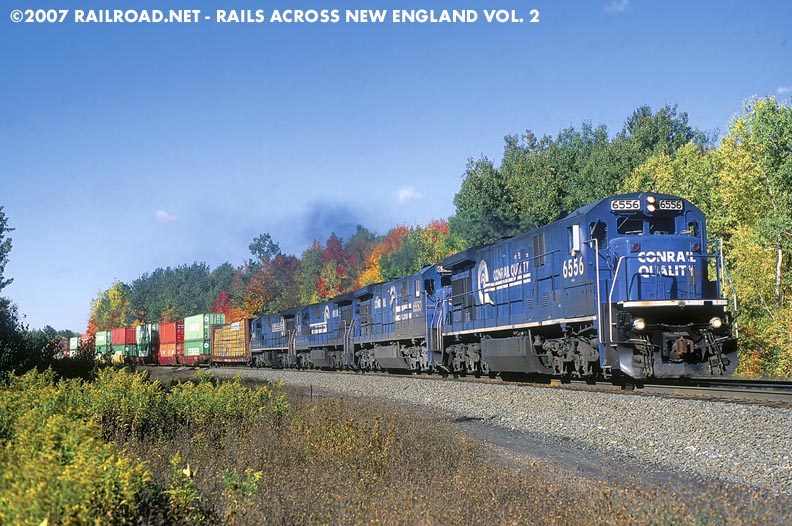
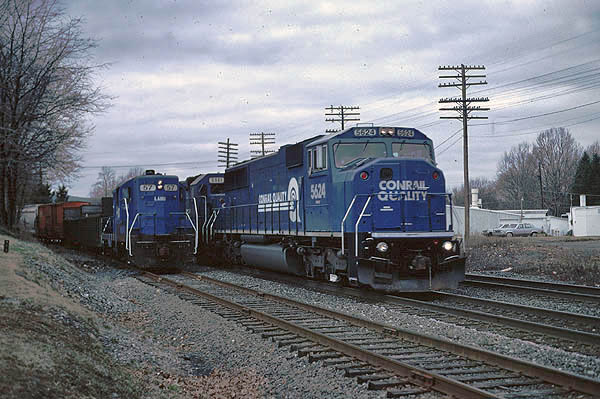
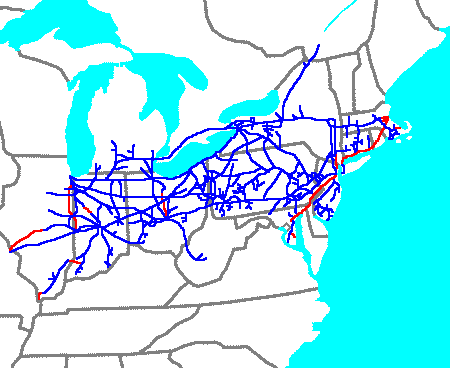
● The Canton Railroad
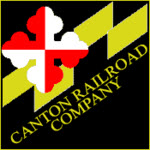
The Canton Railroad Company is a rail logistics provider that offers freight
services to industrial, manufacturing and port related shippers. It is located
in eastern Baltimore City and Baltimore County MD. The railroad was
formally founded in 1906. Eventually the Canton Railroad Company would
be created to serve the industrial heartland of Baltimore.
Their website is here.
From Wikipedia:
History.... After the federal government enacted legislation in 1905 approving the dredging of shipping channels to the Baltimore harbor to a depth of 35 feet, the Canton Company of Baltimore, a marine terminal
operator, sought to develop property it owned in southeast Baltimore for use by manufacturers and shippers. This necessitated access to rail services. Since neither of the two local railroad companies, the
Baltimore and Ohio (B&O) and Pennsylvania Railroad Companies, were willing to extend their lines to undeveloped areas, the Canton Company decided in 1905 to build its own local railroad.
The Canton Railroad Company was chartered in 1906 by the Canton Company, to serve industrial, manufacturing, and shipping customers in the Baltimore port area. Its tracks, starting from the interconnection with
the Pennsylvania Railroad, were laid during the period from 1905 through 1914. The Canton track interconnected with the B&O Railroad in 1910. Rail operations began in 1907.
The Canton Company was purchased by the conglomerate International Mining Company in 1960. It passed through several owners in the 1970s and 1980s. In 1984, alleged financial improprieties by the owners
of the Canton Development Company, then the owner of the railroad, led to its being placed into receivership. The State of Maryland purchased the Canton Railroad at a bankruptcy auction in 1987 for
$875,000 to provide railway access to the Seagirt Terminal of the Port of Baltimore.
The Canton Railroad dispute with Maryland involving whether the state franchise tax on railroad activities in the port of Baltimore violated the Import-Export or Commerce Clauses of the Constitution led to the
Supreme Court case Canton Railroad Company v. Rogan, 340 U.S. 511 (1951).
Current operations: Today the Canton Railroad is owned by the Maryland Transportation Authority and operates as a for-profit enterprise. Engines used by the Canton Railroad are painted yellow and black in a
pattern similar to that used in the Maryland and Baltimore flags. The railroad currently operates 6 miles of mainline and 17 miles of secondary track.

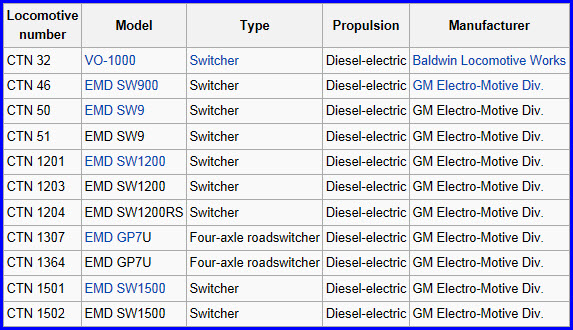
Below is a sampling of Canton engines from the early 80's.
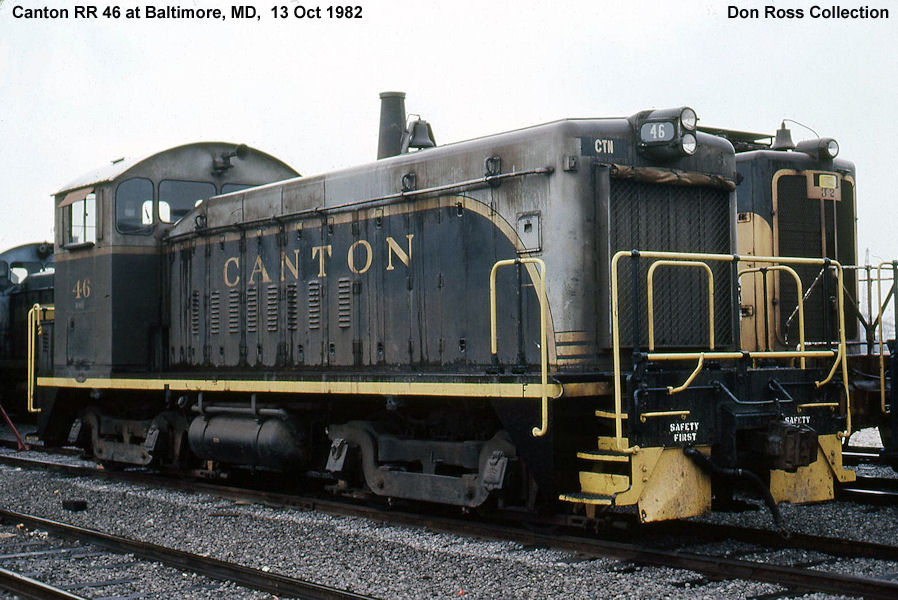
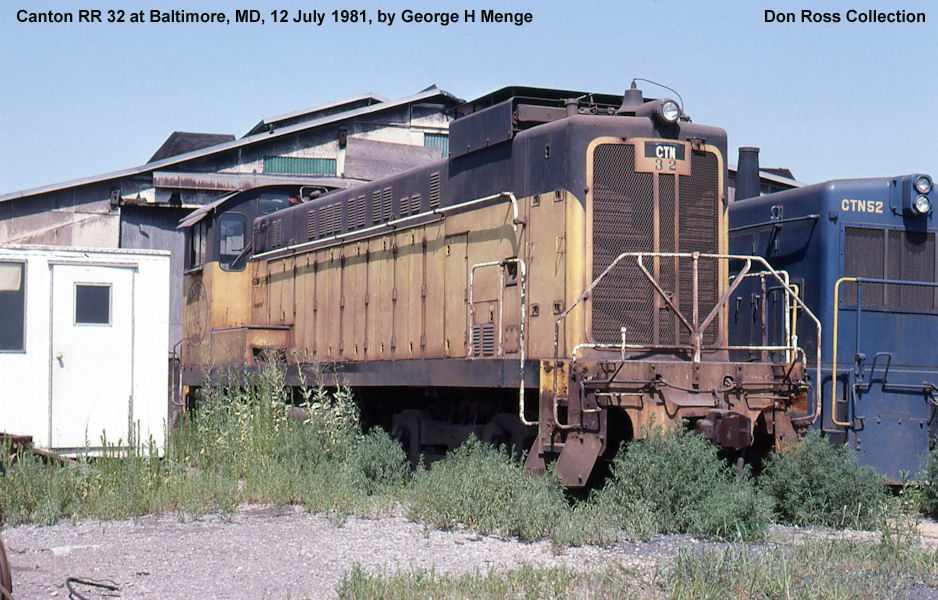
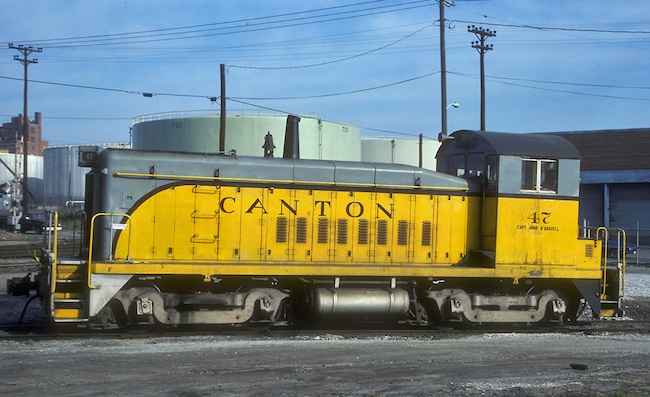
● The Baltimore & Annapolis Railroad
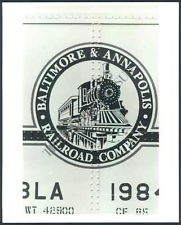

From Wikipedia:
The Baltimore & Annapolis Railroad was an American railroad of central Maryland built in the 19th century. The railroad, the second to serve Annapolis, ran
between Annapolis and Clifford along the north shore of the Severn River. From Clifford, just north of the present day Patapsco Light Rail Stop, it connected with the B&O's Curtis Bay branch so that
trains could travel to Baltimore. In 1921, when it was called the Annapolis and Baltimore Short Line, it was purchased by the larger Washington, Baltimore and Annapolis Electric
Railway (WB&A), and then emerged from the WB&A's 1935 bankruptcy and closure as the Baltimore & Annapolis Railroad. B&A electric passenger
operation between the two cities continued until 1950, at which time the rail line became solely a freight carrier, operating buses for passenger service. Freight service to Annapolis continued until June
1968 when the Severn River Trestle was declared unsafe. In the 1980s the line was completely shut down. The right-of-way now serves as part of Baltimore's light rail system and as the Baltimore &
Annapolis Trail.
The Baltimore & Annapolis Railroad was chartered in 1880, by a group of New England promoters as the Annapolis and Baltimore Short Line and began running in March
1887. This freight and passenger line was an integral link between Annapolis and Baltimore, transporting almost two million passengers per year until competition from nearby highways forced the railroads'
closure. It was the second railroad to serve Annapolis and provided a faster connection to Baltimore, taking a more direct path along the north shore of the Severn River and then crossing the river into
Annapolis. The railroad transformed the once-secluded banks of the Severn to a series of suburban communities.
The railroad started as a steam powered line running from Bladen Street in Annapolis, crossing the wide Severn River estuary on a long timber trestle, and on to Clifford on the B&O line, where it used
the B&O tracks to terminate at Camden Station in Baltimore. Because the A&B Short Line created an almost straight line southeast from Baltimore it snatched much of the Baltimore-Annapolis trade
away from the Annapolis, Washington & Baltimore Railroad on which passengers had to change trains at Annapolis Junction.
At some point prior to 1892, a small connecting line was built between the A&B and the AW&B at the Bay Ridge Junction wye where the AW&B met the Annapolis and Bay Ridge Railroad.
Reorganization: Business was slim in the early years, and in 1893 the railroad was sold to George Burnham Jr. and reorganized as the Baltimore & Annapolis Short Line the next year. Universally
it was called simply “The Annapolis Short Line.”
Modernization: The line was electrified in 1908, and changed its name to the Maryland Electric Railways Company, providing clean, comfortable, faster, and more frequent
service. Unlike most electric railways of its time, which employed a low voltage Direct Current electrification, the line installed a 6,600 volt, 25 cycle, single phase Alternating Current electrification
system newly developed by the Westinghouse Electric & Manufacturing Company. The pioneering AC system was less than fully successful, however, and in 1914, new owners switched to DC. When it did,
the B&O was wary of a high-voltage overhead line over its tracks between the Clifford interchange and Camden Station. (Both the WB&A and Short Line then used 3300v AC) So the B&O built a new line for
the Short Line between Cliffords and its mainline at Russell Street, paralleling the South Baltimore branch through Westport. This line ran immediately west/south of the Curtis Bay and South Baltimore
branches, passing under the Curtis Bay branch along the way.
Purchase: During its heyday, the years between 1918 and the late 1920s, the B&A transported as many as 1,750,000 passengers per year between Baltimore and Annapolis. Trains left every hour from 6 am through
11 pm (during rush hours, the trains left every 30 minutes). Because of its strong performance, the neighboring WB&A bought the Annapolis Short Line in 1921 and it became part of the WB&A system in
which it was called the North Shore Line. Afterward, Short Line trains were routed over the WB&A between Linthicum and the WB&A's new Baltimore terminal at the corner of Howard & Lombard Streets,
now the site of a Holiday Inn. At the same time, most of the old Short Line track between Linthicum and Westport was abandoned, except for a section between Baltimore Highlands and the B&O Cliffords
interchange which was kept to handle freight to and from the B&O. The "new" (B&O-built) Annapolis Short Line ROW between Cliffords and Westport was also retained for freight interchange, though
this segment was later abandoned in 1979.
The End: Following World War II, gasoline and cars came back. At a hearing in November 1949, the Maryland Public Service Commission reported "The rails are worn and would have to be replaced if passenger
service is continued; the cars and trains are antiquated, decrepit, and unattractive means of travel; schedules are slow, and there is no inducement, save that of necessity, for anyone to travel the area by rail.
While not yet dead, it is moribund”. The B&A substituted buses for rail service: by February 5, 1950, the B&A Short Line made its final passenger run. The electric wires were removed, but the
railroad remained intact for diesel-operated freight service. The B&A purchased a diesel that remained in freight service to Annapolis until June 1968 when the Severn River Trestle was embargoed.
The freight was now terminated at Jones Station where Annapolis Lumber and Supply Company sent trucks to collect freight. At this time, the Naval Academy converted their power and heating systems from coal to
oil. By the early 1970s, all that remained in service was a six-mile (10 km) stub to Glen Burnie.
The Baltimore & Annapolis Railroad's public bus system was absorbed by Maryland Transit Administration (MTA) in 1973 as Route 14. The company continued as a charter bus service using motorcoaches into the
mid-1980s, but eventually ceased service.
In 1979, Anne Arundel County purchased the 66-foot (20 m) wide corridor between Glen Burnie to Arnold for the purpose of creating the Baltimore & Annapolis Trail and park. The remaining line north of
Glen Burnie was shut down in the early 1980s and sold to the State of Maryland to serve as the southern leg of the light rail system. In 1986, B&A number 50 was donated to the B&O Railroad Museum.
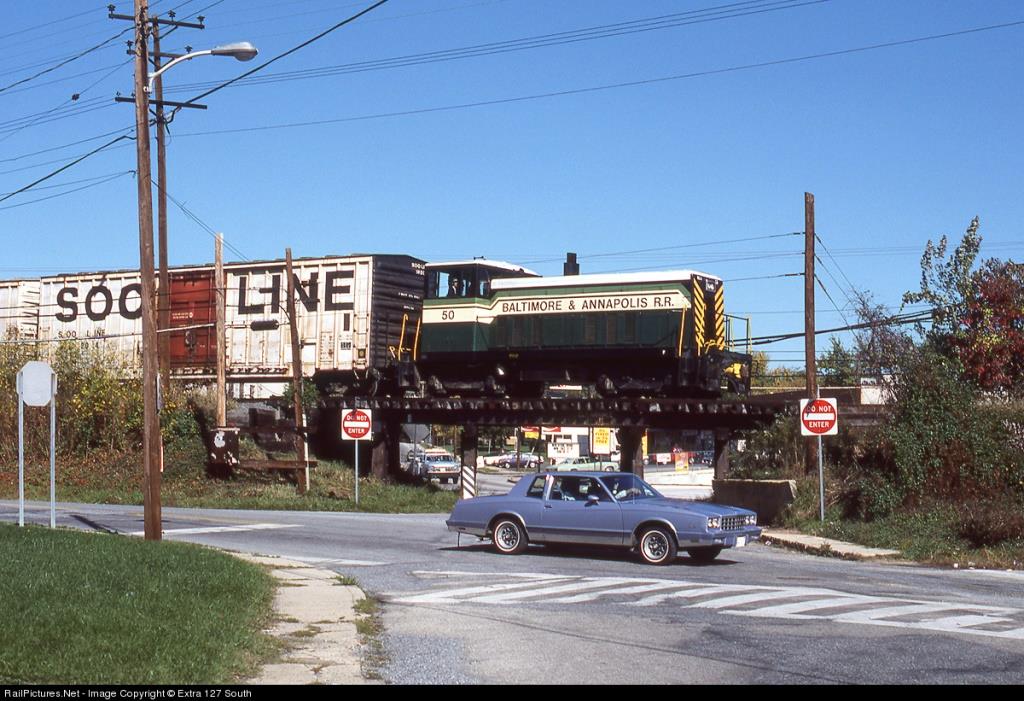
Down in Glen Burnie, the light rail still uses this short trestle.
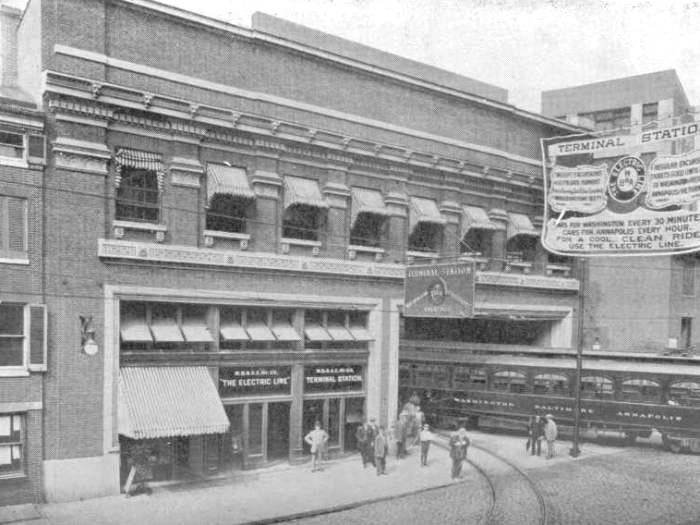 In downtown Baltimore
In downtown Baltimore
 Map showing WB&A system, including former B&A line.
Map showing WB&A system, including former B&A line.
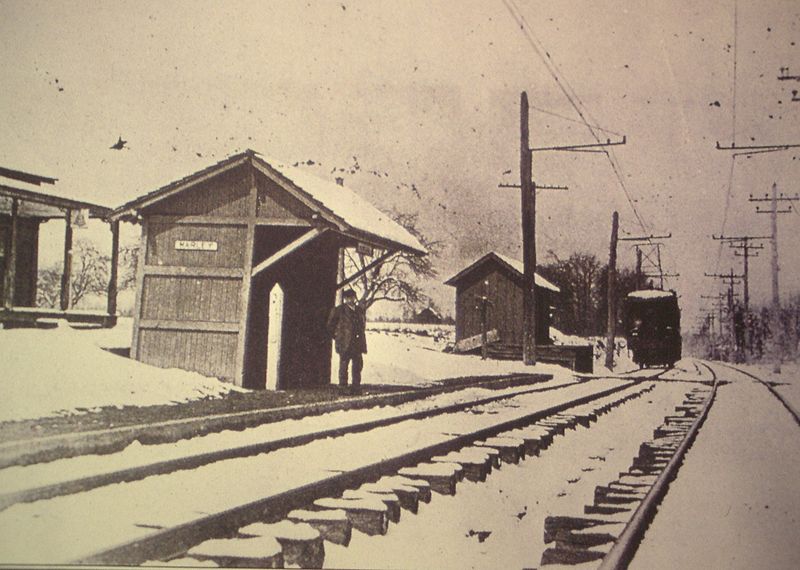 Marley Station 1944.
Marley Station 1944.
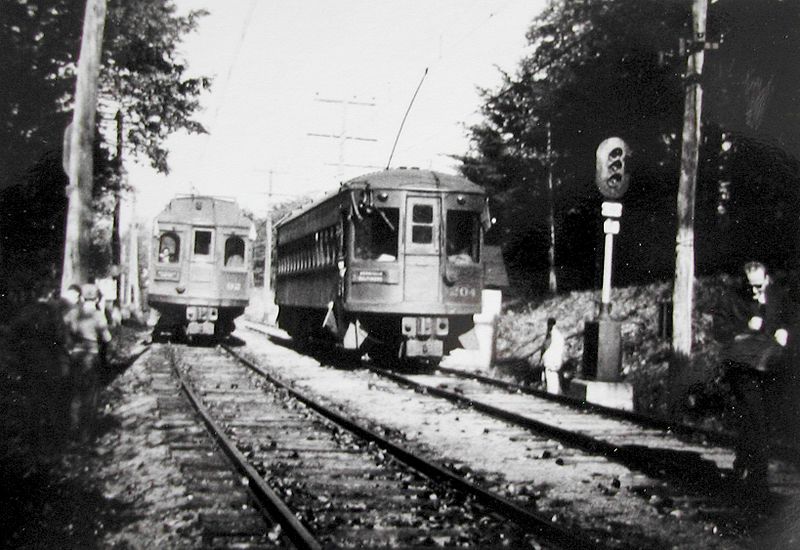 Arnold Station 1945.
Arnold Station 1945.
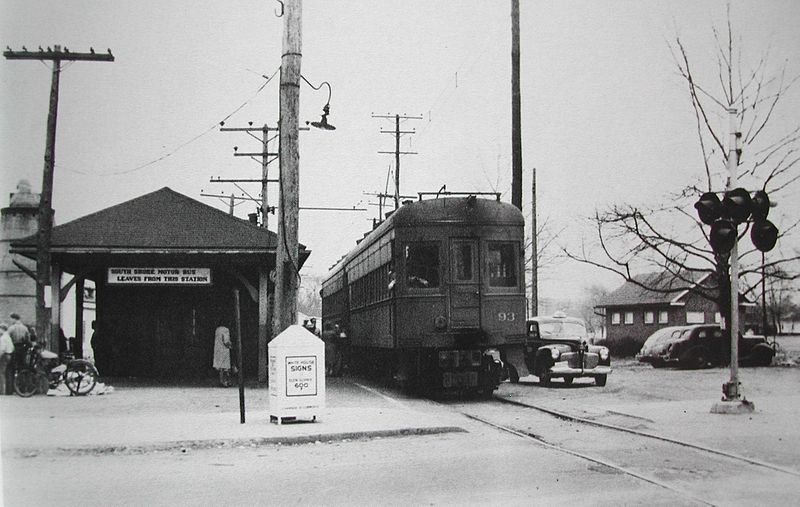 Glen Burnie Station 1941.
Glen Burnie Station 1941.
● the Philadelphia, Wilmington and Baltimore Railroad

From Wikipedia:
Around 1830, the Pennsylvania state legislature sought to
improve transportation between Philadelphia and points
south. On April 2, 1831, it chartered the
Philadelphia and Delaware County
Rail-Road Company, allotting $200K to build a rail
line from America's largest city to the Delaware state line.
In July 1835, surveyors began to look at possible routes, and in
October they reported that the best option, a 17-mile line, would
cost $233K to build.
Meanwhile, the Delaware and Maryland legislatures were doing their
part to create a rail link to Wilmington and Baltimore. On
January 18, 1832, Delaware chartered the
Wilmington and Susquehanna RR Co (the W&SRRC) with
$400K to build from Wilmington to the Maryland state line.
On March 5, Maryland chartered the Baltimore
and Port Deposit RR Company (B&PD), with $1,000,000,
to build from Baltimore to the western bank of the Susquehanna
River. The B&PD began operating trains in 1835, in
Baltimore between the Basin waterfront (today, it's known
as the Inner Harbor) and the Canton area.
On March 12, the Delaware and Maryland
Rail Road Company (D&MRRC) was chartered for
$3,000,000 to build from Port Deposit or any other
point on the Susquehanna's eastern bank to the Delaware line.
The year 1836 saw several milestones. The
P&DCRRC opened its first segment of track, the state upped the
railroad's allowable expenditures to $400,000, and the company
changed its name, on March 14, to The
Philadelphia, Wilmington and Baltimore Railroad Company
. On July 4, the PW&B began building
its bridge over the Schuylkill River, the most significant obstacle
on its route. The bridge would cross at Gray's Ferry, south of
the city.
Work proceeded in Delaware and Maryland as
well, and by July 1837, there was continuous track from Baltimore to
Wilmington, broken only by the wide Susquehanna River, which trains
crossed by ferry at Havre de Grace.
On January 15, 1838, the PW&B opened service
from Gray's Ferry to Wilmington. In December, the Schuylkill bridge
was completed. Named the Newkirk Viaduct after PW&B president
Matthew Newkirk, it allowed trains to run from downtown Philadelphia
to downtown Baltimore, with only the Susquehanna ferry interrupting
the ride.
The Baltimore & Ohio Railroad (B&O) began using
the tracks that same year to offer service to Philadelphia.
The disadvantages of tripartite ownership of
the Philadelphia-Baltimore line had become obvious. The
D&MRRC and the W&SRRC had already merged to form the
Wilmington and
Susquehanna Railroad Company on April 18, 1836.
On February 12, 1838, the four state-chartered railroads were
merged to form the Philadelphia, Wilmington
and Baltimore Railroad Company. (The new company's
name differed from its predecessor's in that "The" was
not part of its formal name).
More.....
In Philadelphia, the line
ended at Broad Street and Prime Avenue (today Washington Avenue),
where it connected with the Southwark Rail-Road (built in 1835)
to reach the Delaware River.
In 1839, the railroad's ticket agents advertised daily mail-and-passenger
trains that left Baltimore's Pratt Street station at 9:30 a.m.,
stopped for lunch in Wilmington, and reached the Market Street depot
in Philadelphia at 4 p.m.
In 1842, Newkirk resigned as PW&B president. He was replaced by
Matthew Brooke Buckley (1794-1856), who had become a PW&B board
member on Jan. 10, 1842, and one week later had taken over
leadership of one of the railroad's three executive committees, the
Northern one. As president, Buckley helped create the first
telegraph line from Philadelphia to Baltimore (and hence from points
north and south) by agreeing to allow the builder to use the PW&B
right-of-way in exchange for the use of the communications equipment.
In Baltimore, the PW&B ended at President Street. In 1850,
the railroad opened a new station, with a 208-foot (63 m)
barrel-vaulted train shed. Service onward to Washington, D.C.
was facilitated by drawing the coaches by horse down Pratt Street to
the B&O terminal. Unwieldy as it was, the arrangement allowed
the railroads to compete with the Philadelphia and Columbia Railroad
(Pennsylvania Railroad after 1857) on routes west from Philadelphia.
By 1853, the Camden and Amboy Railroad and New Jersey Railroad were
also part of this agreement, providing through service from New York
City to the west.
The PW&B also extended its reach into Delaware — on March 15,
1839, it bought the New Castle and Frenchtown Turnpike and Rail Road
running from New Castle DE to Frenchtown MD but it took 13 years to
connect the line to the rest of the PW&B. The New Castle and
Wilmington Railroad was chartered to do so, and opened in 1852.
The line also provided a connection with the Delaware Railroad,
which the PW&B took over and began to operate on January 1, 1857. In
1859, the NC&F was abandoned west of Rodney, the junction with the
Delaware Railroad. By 1866, these moves and others allowed the PW&B
to dominate the Delmarva Peninsula rail market.
In November 1866, the Susquehanna was bridged at last by the PW&B
Bridge, a 3,269-foot (996 m) wooden truss, creating a continuous
rail connection between Philadelphia and Baltimore.
To avoid swampy areas and serve more populated ones, the PB&W
built the Darby Improvement, which diverged from its existing main
line just south of the Grays Ferry Bridge, passed through Darby, and
rejoined it at Eddystone, just upriver from Chester. The new
inland track opened on November 18, 1872. The PW&B dispensed
with the old alignment less than a year later, leasing it on July 1,
1873, to the Philadelphia and Reading Railway for 999 years with the
stipulation that it would be used solely for freight. (The
Reading dubbed the line, along with some connecting track, its
Philadelphia and Chester Branch, southbound trains reached it via
the Junction Railroad (jointly controlled by PW&B, Reading, and PRR)
and continued on to the connecting Chester and Delaware River
Railroad.)
The PW&B, which had competed so fiercely with the PRR, began to
see their interests align. In 1873, the PRR opened the Baltimore and
Potomac Rail Road from Baltimore to Washington. The PW&B agreed to
allow the PRR to use its track between Philadelphia and Baltimore,
helping the PRR to offer a shorter and more direct trip to
Washington.
On May 15, 1877, the PW&B formally absorbed the New Castle &
Frenchtown and New Castle & Wilmington railroads, forming a branch
line from Wilmington to Rodney. On May 21, 1877, it absorbed the Southwark
Railroad, extending its main line to the Delaware River
waterfront.
PRR subsidiaries.....
A number of branches were built, bought and sold from 1881 to
1891, as described below. In 1895, the main line was realigned and
straightened at Naaman's Creek in Delaware. The old line would
become sidings for Claymont Steel.
The PRR's Baltimore and Potomac Rail Road was formally leased to
the PW&B on November 1, 1891.
The Elkton and Middletown Railroad, opened in 1895, was
originally intended as a cutoff between the main line at Elkton,
Maryland and the Delaware Railroad at Middletown, Delaware. However,
only a short piece of track serving industries in Elkton was ever
constructed. It was consolidated into the PB&W on September 15,
1916.
The PW&B merged with the Baltimore and Potomac
on November 1, 1902, to form the
Philadelphia, Baltimore and Washington Railroad.
Branches.....
● Southwark
● 60th Street/Chester
● South Chester
● Edgemoor
● Augustine Mill: Also called the Brandywine Branch, it
was built in 1882 from Landlith north along the Brandywine Creek
to reach the Augustine Mills of the Jessup & Moore Paper
Company, and was later extended further north to serve the
Kentmere and Rockford Mills of Joseph Bancroft & Sons.
● Shellpot: Also called the Shellpot Cutoff, it was
built in 1888 from Edgemoor (near the crossing of the Shellpot
Creek) around the south side of Wilmington to a point on the
main line between Wilmington and Newport. It served as a freight
bypass, to avoid what was then street running on the main line
through Wilmington.
● Delaware Branch: Formed from the old New Castle &
Frenchtown and New Castle & Wilmington trackage between
Wilmington and Rodney, via New Castle. It was sold to the
Delaware Railroad in 1891.
● New Castle Cut-off: Built in 1888 from a point on the
Shellpot Branch just across the Christina River from Cherry
Island, south to New Castle and a connection with the Delaware
Branch. It was sold with the Delaware Branch to the Delaware
Railroad in 1891.
● Delaware City: Sold by the Newark and Delaware City
Railroad to the PW&B in 1881. It ran south and east from the
main line at Newark to Delaware City.
● Port Deposit: Built in 1866 up the Susquehanna River
from Perryville to the river town of Port Deposit. In 1893, it
was sold to the Columbia and Port Deposit Railway, also
PRR-controlled, which connected with it at Port Deposit.<
● Baltimore Union
The map below shows the route of the PW&B's tracks through
downtown Baltimore to connect with the B&O RR.
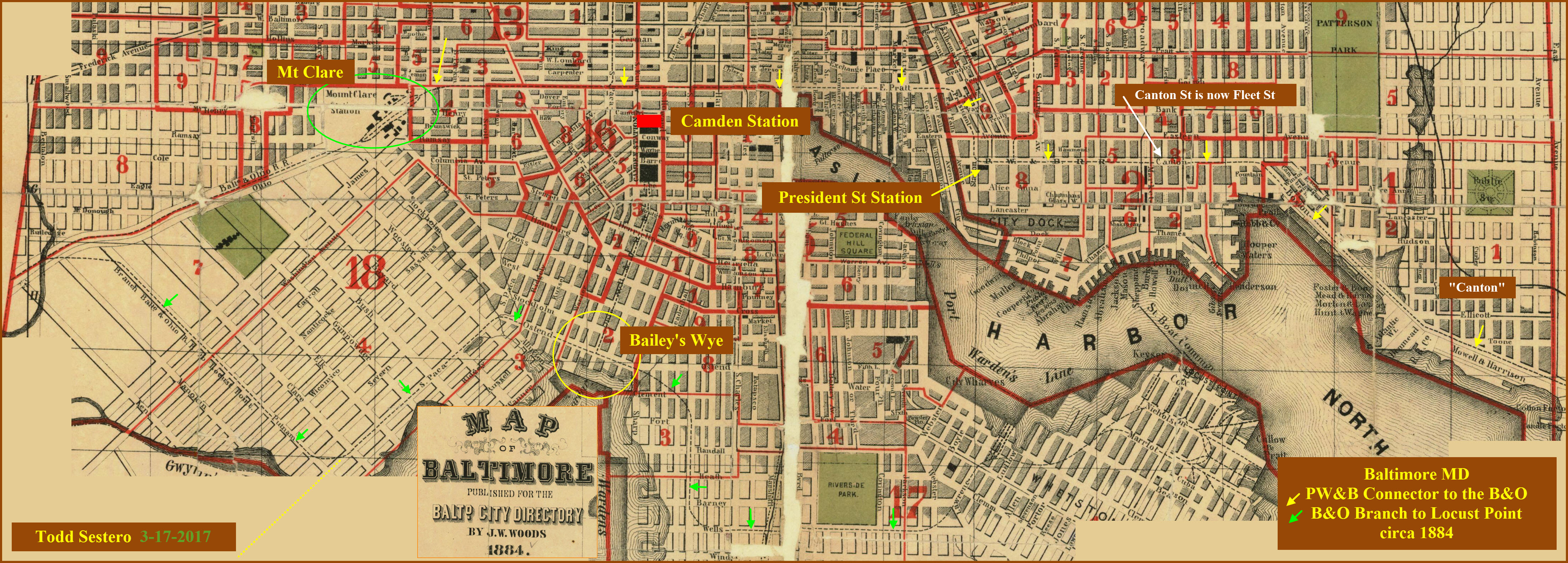
● the Union RR
From Wikipedia, as part of a story on the Union Tunnels......
https://en.wikipedia.org/wiki/Union_Tunnel_(Baltimore)
The Union Railroad was 9.62 miles (15.48 km) in length, extending from
the northern terminus of the Baltimore and Potomac Rail Road to the southern
terminus of the Northern Central Railway. The junction with the Baltimore and
Potomac lies between Pennsylvania Station and the northern portal of the
Baltimore and Potomac Tunnel. The Union Railroad joined the
Northern Central at Bayview Junction, on the northeast side of Baltimore.
Although chartered as early as 1866, active steps to finance construction
of the railroad and tunnel came only in the autumn of 1870, and actual
construction begun May 1, 1871. On July 24, 1873, the first train
passed through the tunnel. The original tunnel began at Bond
Street, and passed under the bed of Hoffman Street to Greenmount
Avenue, crossing under Dallas, Caroline, Spring and Eden Streets,
Central and Harford Avenues, and Ensor, Valley and McKim Streets.
It's length is 3,410 feet (1,040 m). The total cost of
the road and tunnel was some $3,000,000.
As soon as the Union Railroad was completed, the Northern Central
Railway obtained the right to use it, and in February, 1882, the
Northern Central purchased the Union Railroad stock from the Canton
Company, and assumed control March 1 of the same year.
In the map below, the railroad ran between the two yellow arrows.
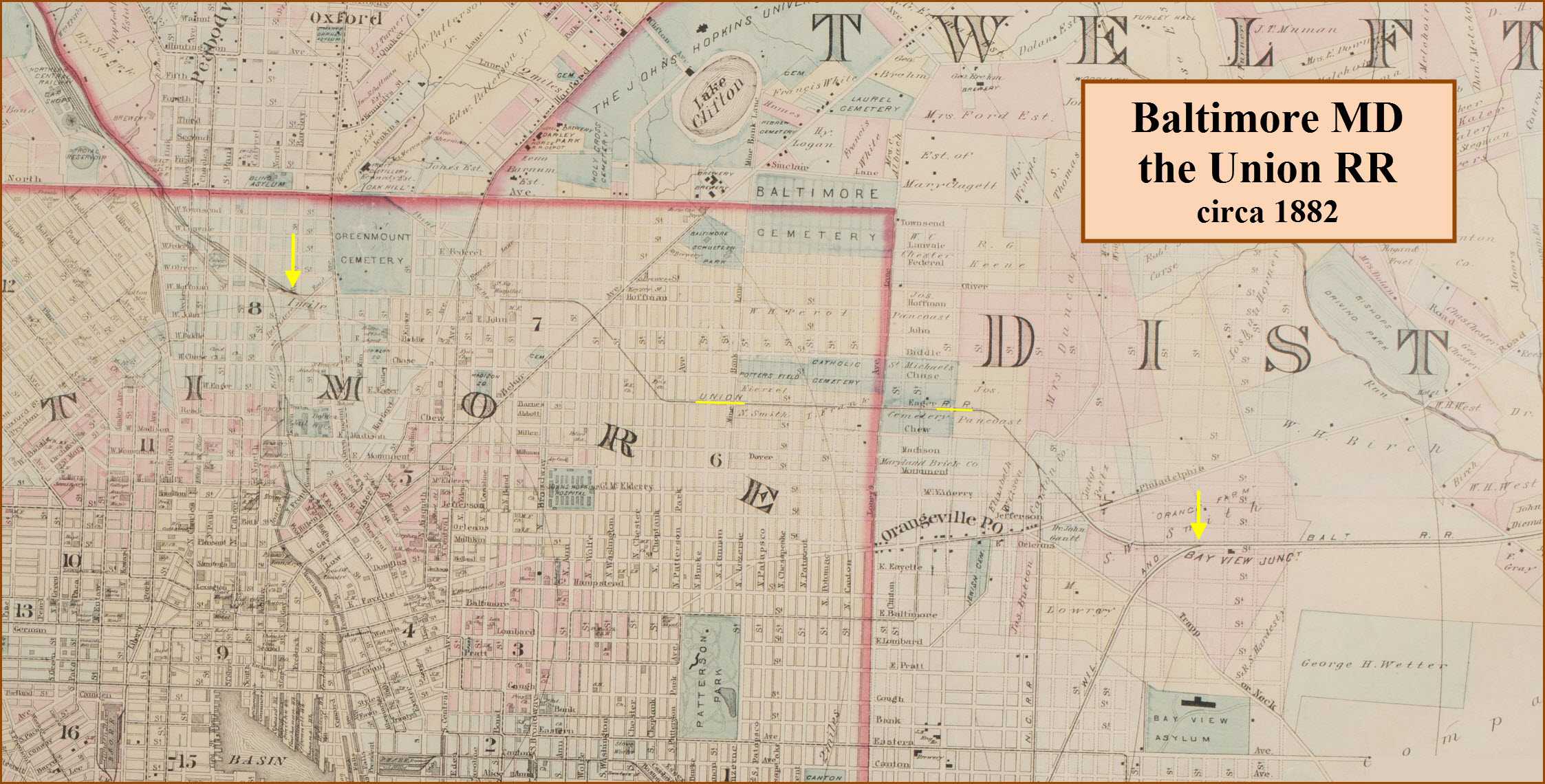
Significant Historical Events
On January 4, 1987, Amtrak Train 94 crashed into a Conrail
freight locomotive in Chase. The Conrail engineer had been smoking
marijuana, which caused him to miss numerous warning signals and take his train
into the path of the approaching Amtrak train. Fourteen
passengers were killed, making this Amtrak's deadliest crash ever at the time.
The crash became national news and led to: 1) New safety regulations, 2) Drug
testing, and 3) Black box recorders on the locomotives. The crash also caught the attention of
President Ronald Reagan, who honored some of the local people of Chase for
helping passengers who escaped shaken but unharmed from the trains. The
community now known as Chase was originally founded as "Chase's Station" in 1850
as a stop for the Baltimore Railroad. Ham Radio also played a role in
emergency efforts because the existing "911" communications systems were
over burdened. Most from Wikipedia - notice they have the
name of the railroad WRONG, and this folks is why teachers don't like students to use
Wikipedia as a reference source for research.
Merger Map
There are also a few family history charts I have put together, located
here.

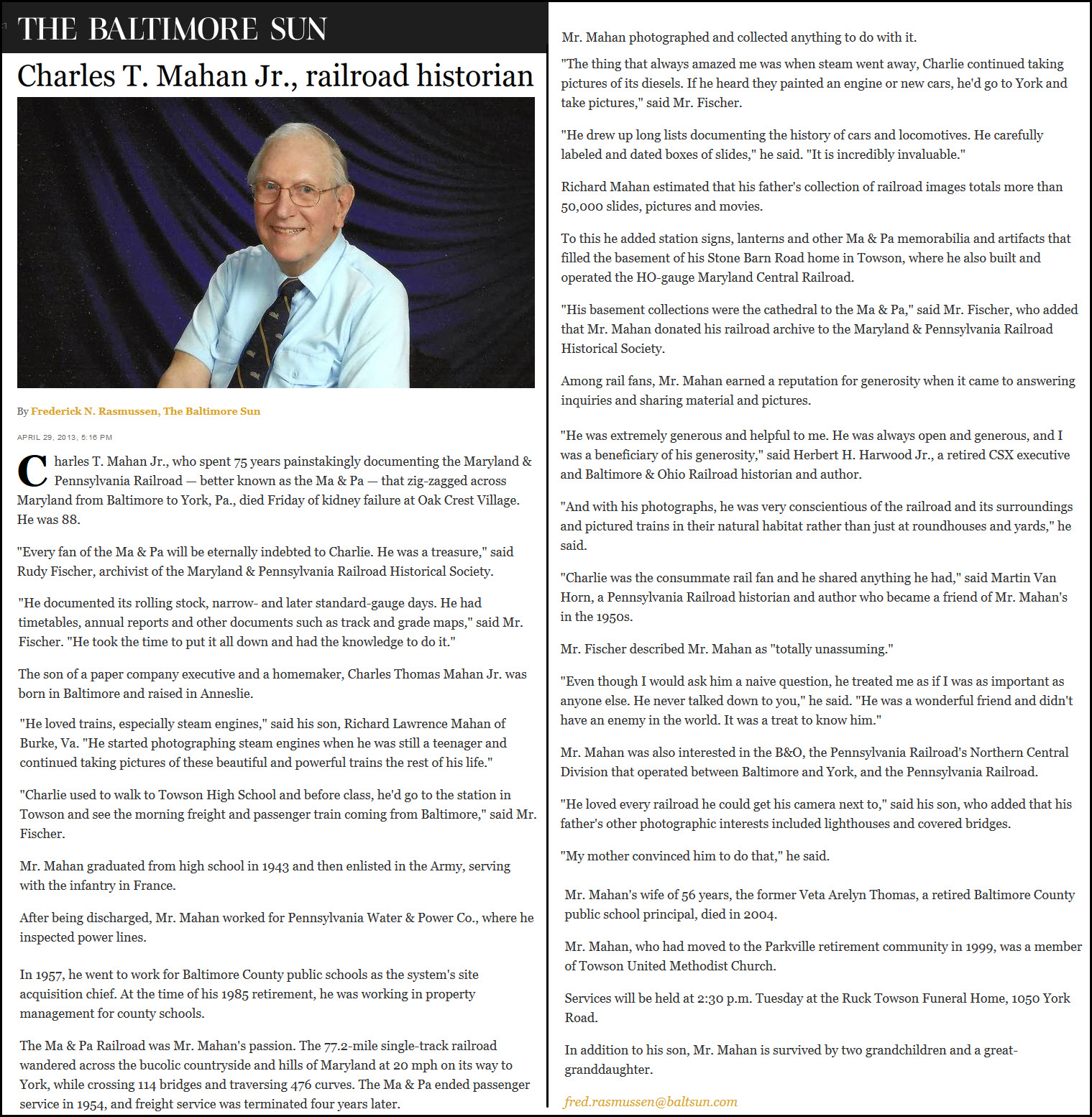
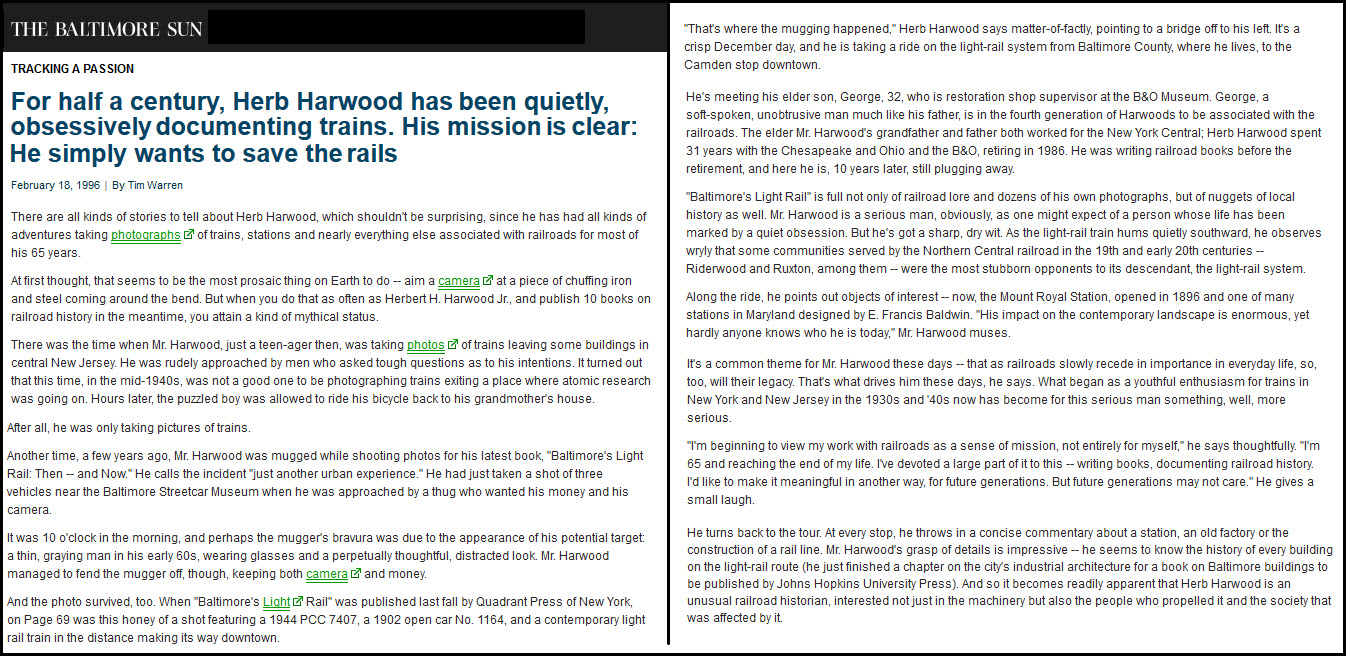
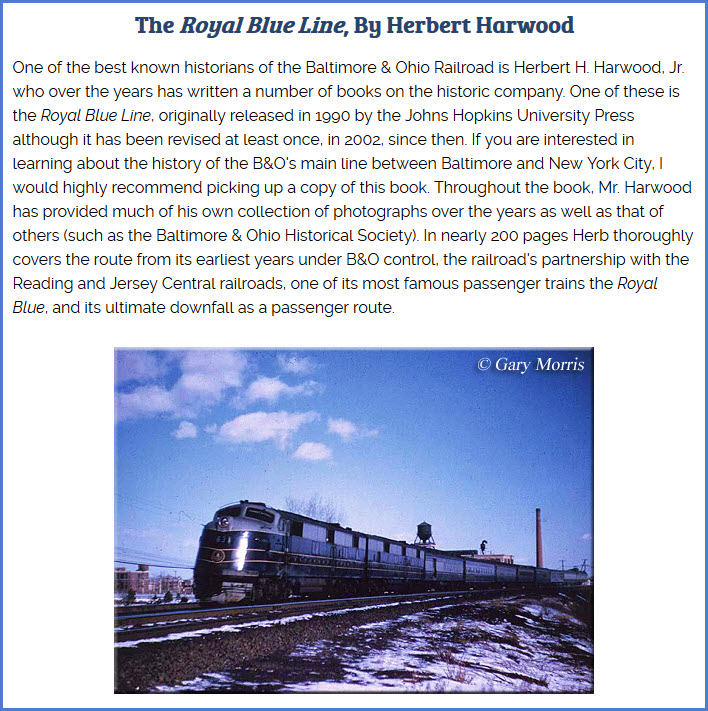

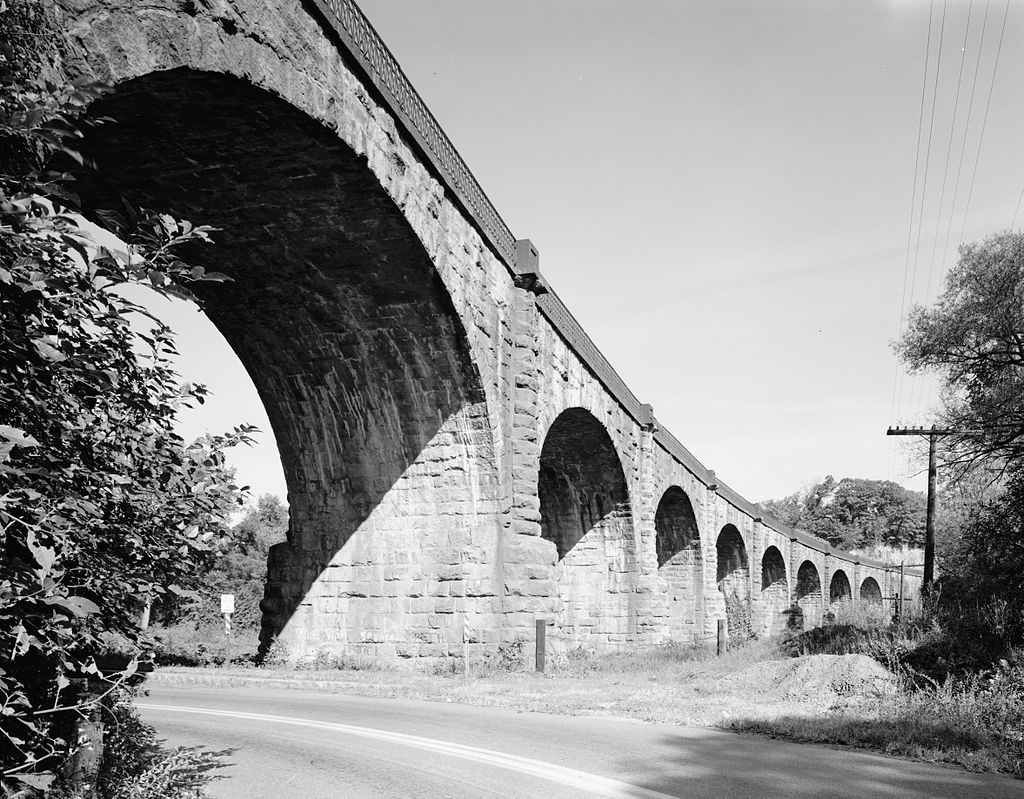 HAER MD-3-8
HAER MD-3-8
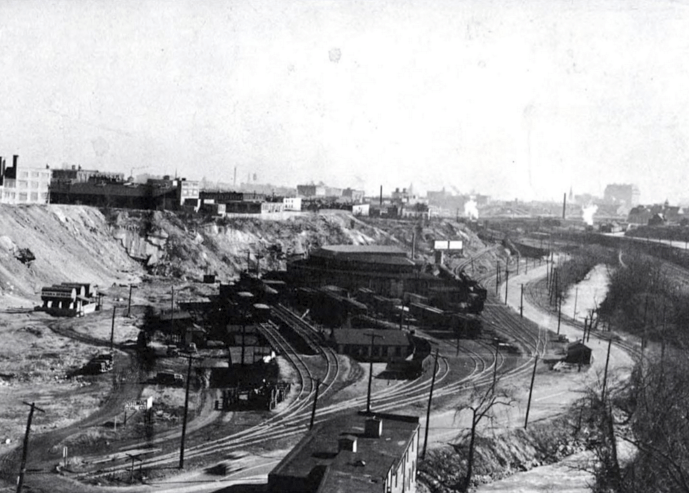
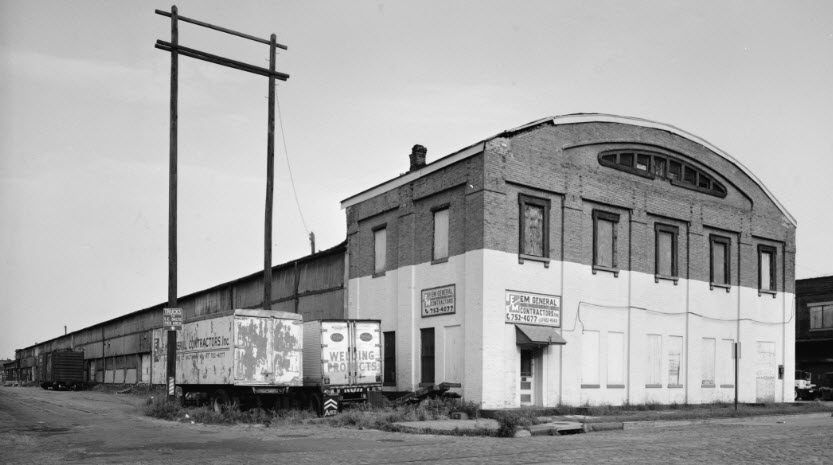

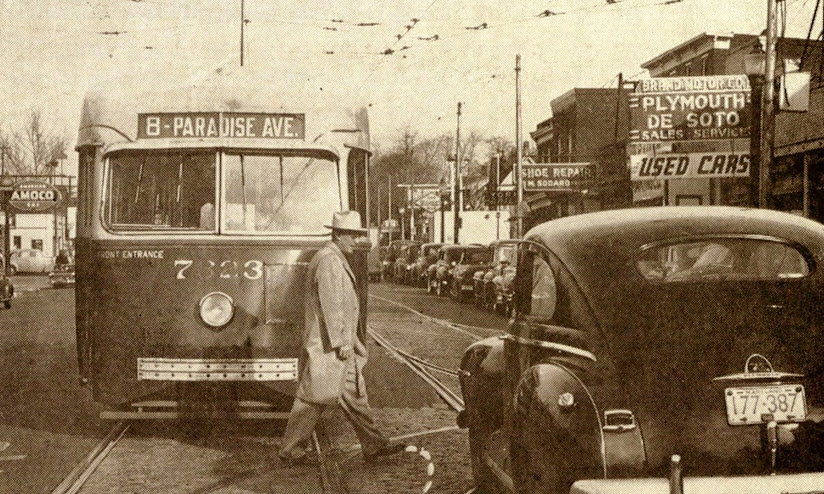 A PCC
car, probably on Frederick Rd, probably in 1950 because of the license plate
A PCC
car, probably on Frederick Rd, probably in 1950 because of the license plate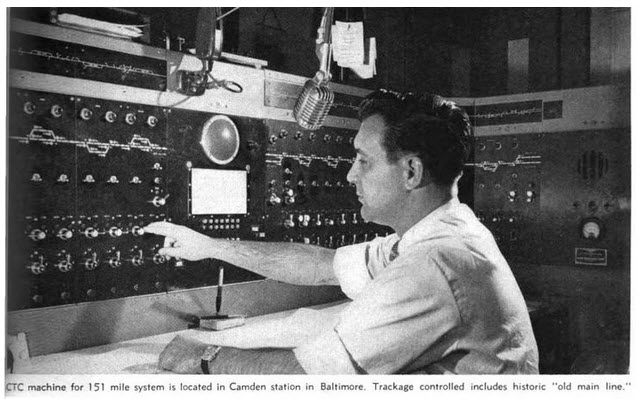
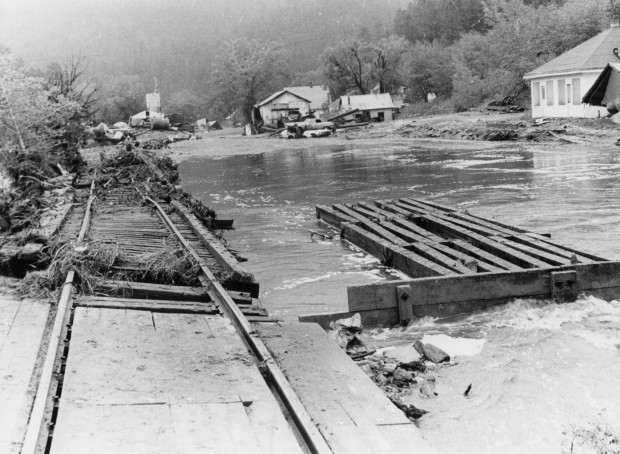 Scene similar to the OML in 1972
Scene similar to the OML in 1972 in Brunswick MD, Picture by George Hamlin
in Brunswick MD, Picture by George Hamlin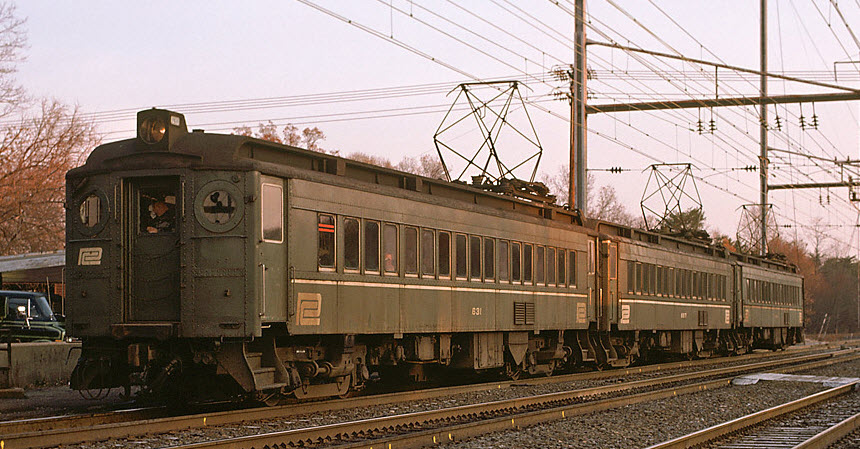 Picture by George Hamlin
Picture by George Hamlin

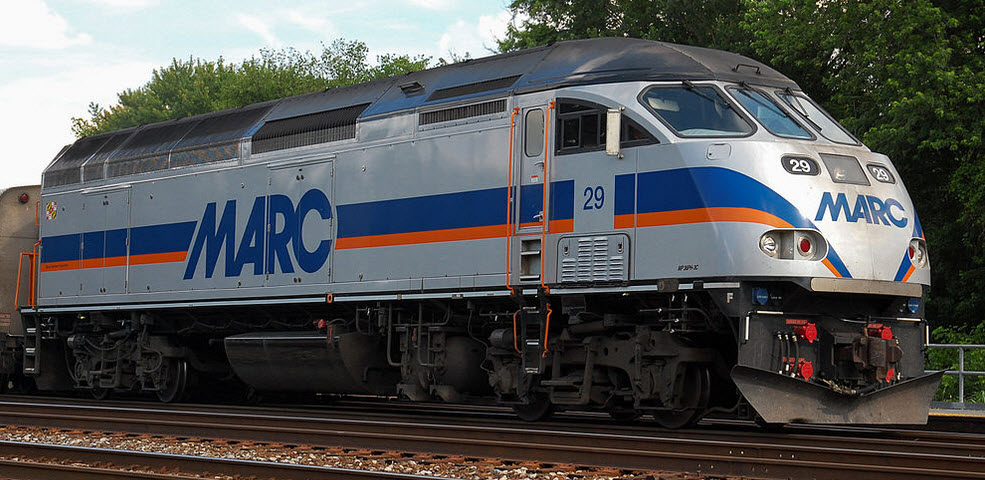

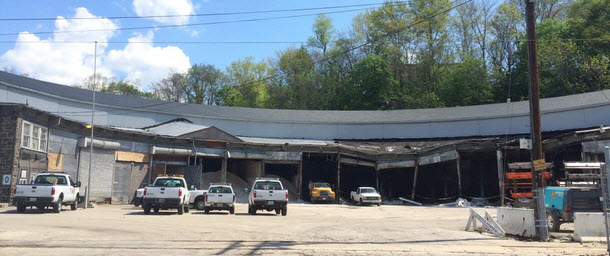 Photograph by Eli Pousson, 2May2015
Photograph by Eli Pousson, 2May2015

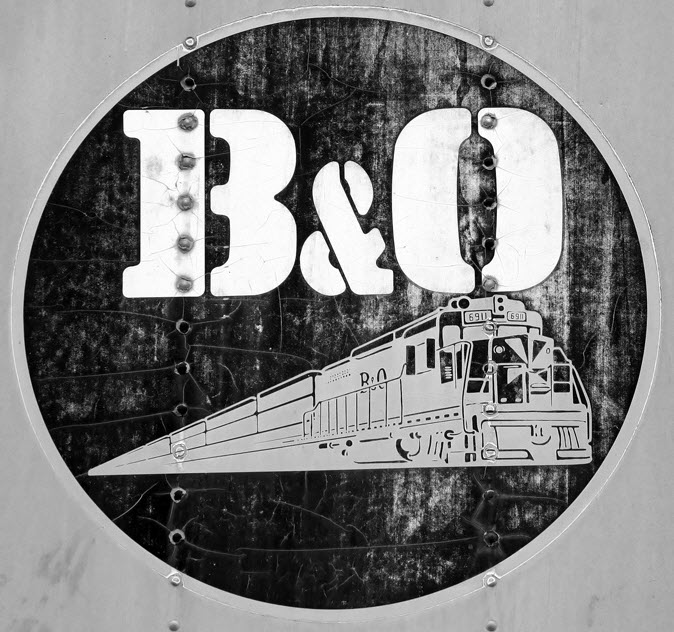
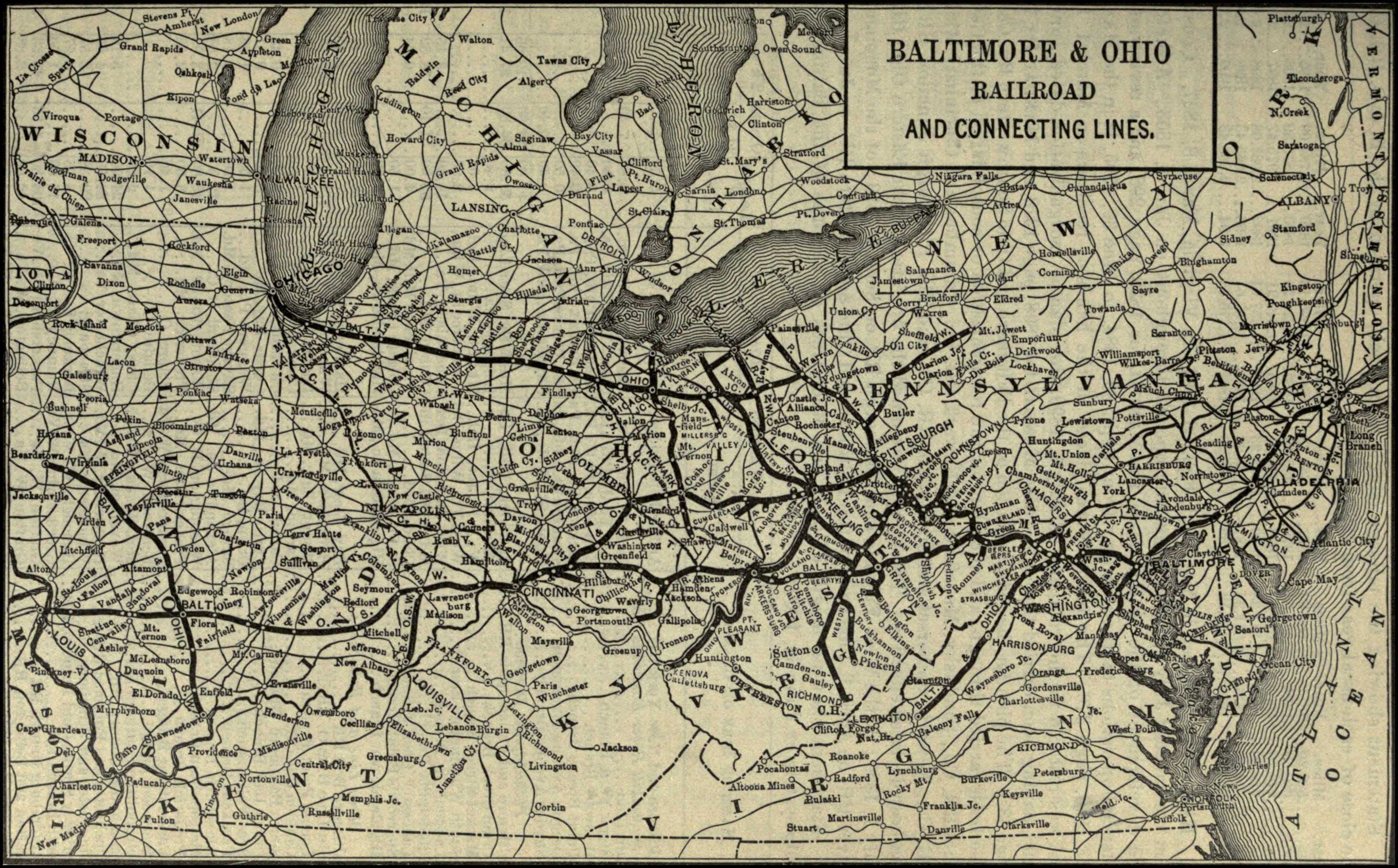
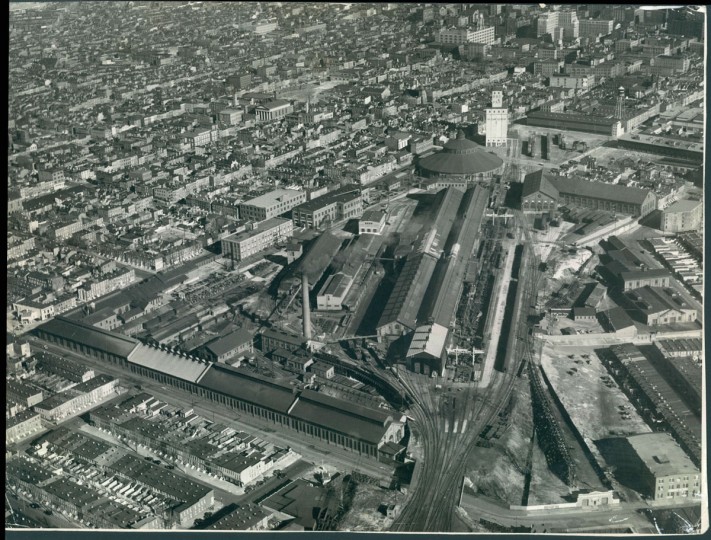 Mt Clare in Baltimore
Mt Clare in Baltimore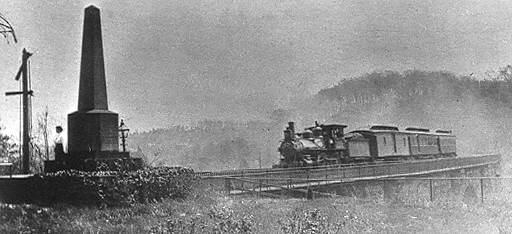 Around 1900 at Thomas Viaduct, headed towards Baltimore
Around 1900 at Thomas Viaduct, headed towards Baltimore
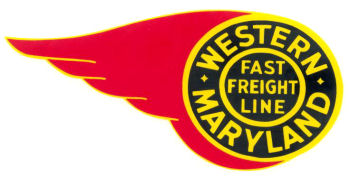
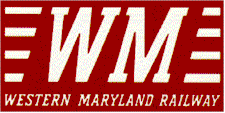
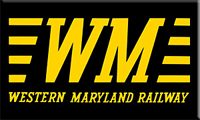

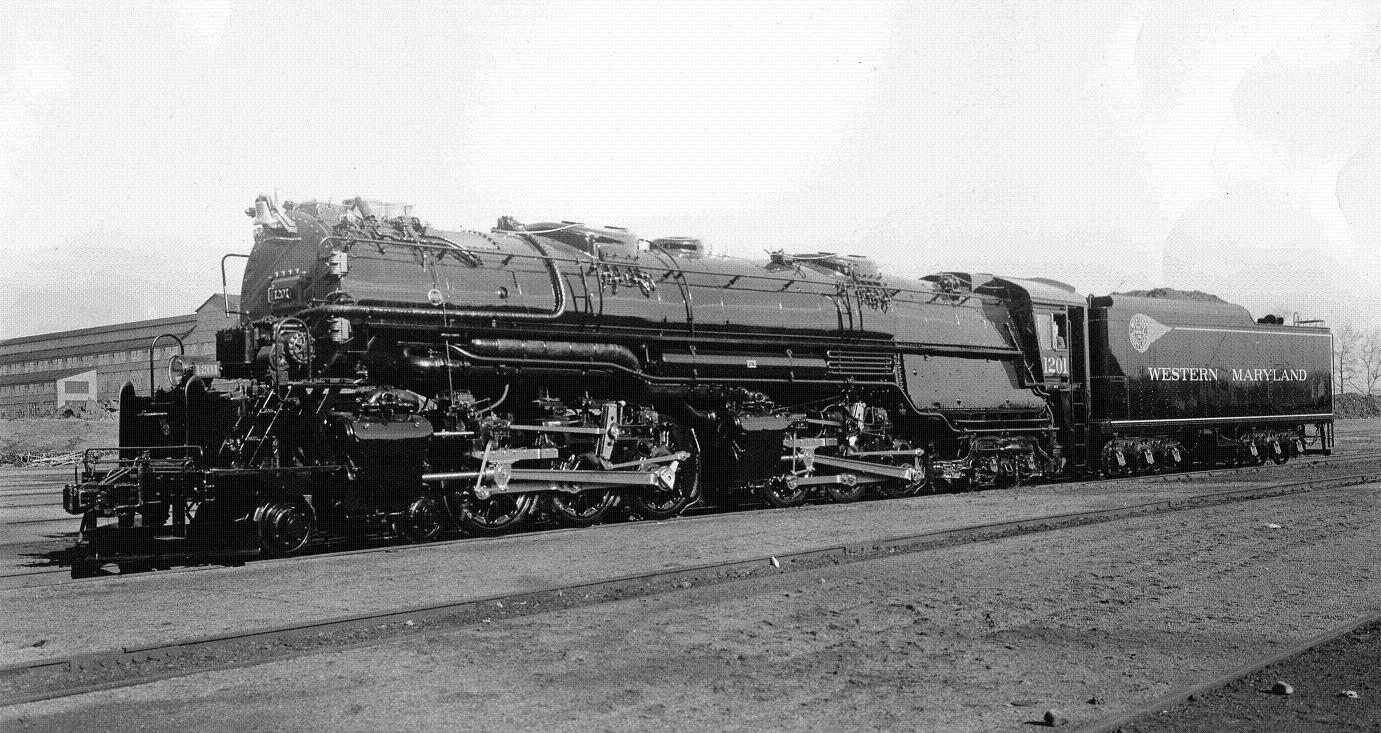
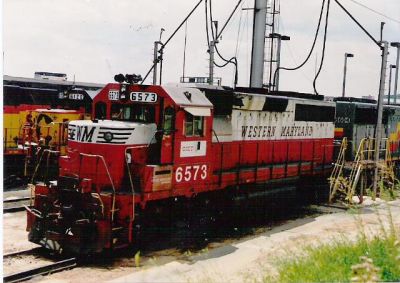

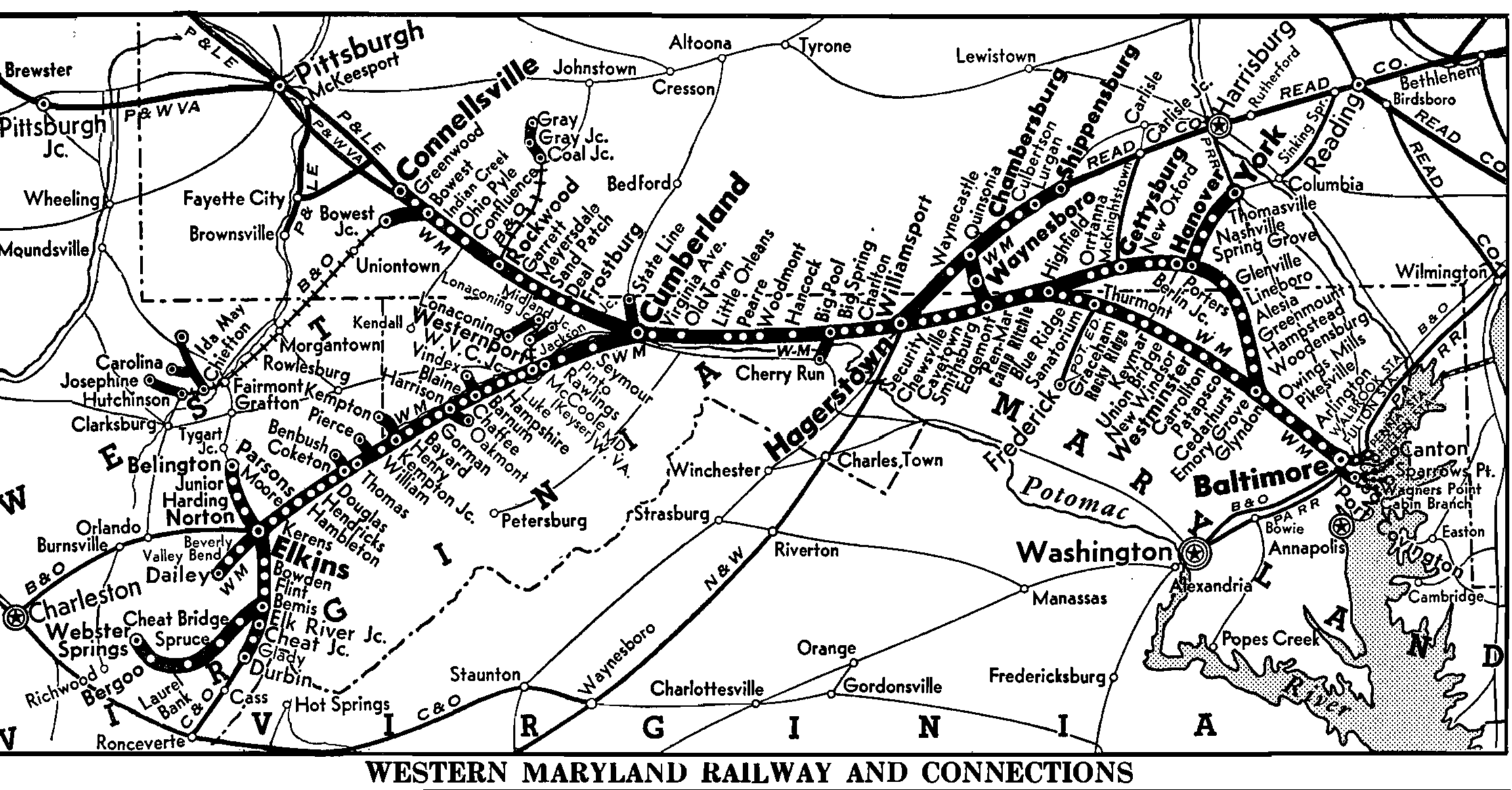
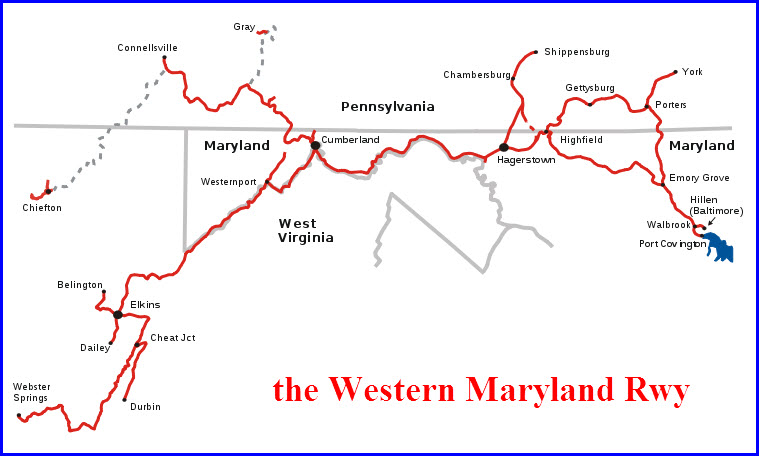
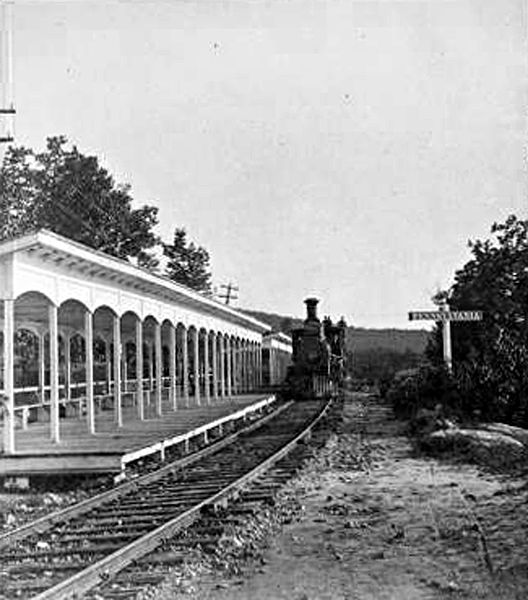 WM Penn Mar Station in 1878, photo by EM Recher.
WM Penn Mar Station in 1878, photo by EM Recher.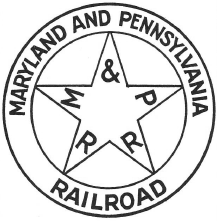
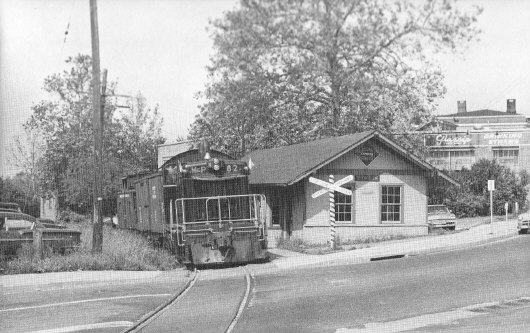

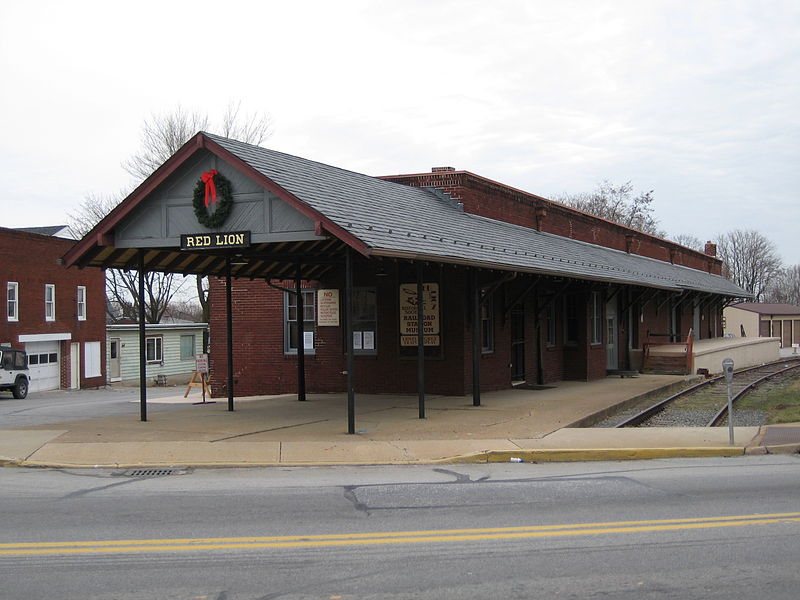
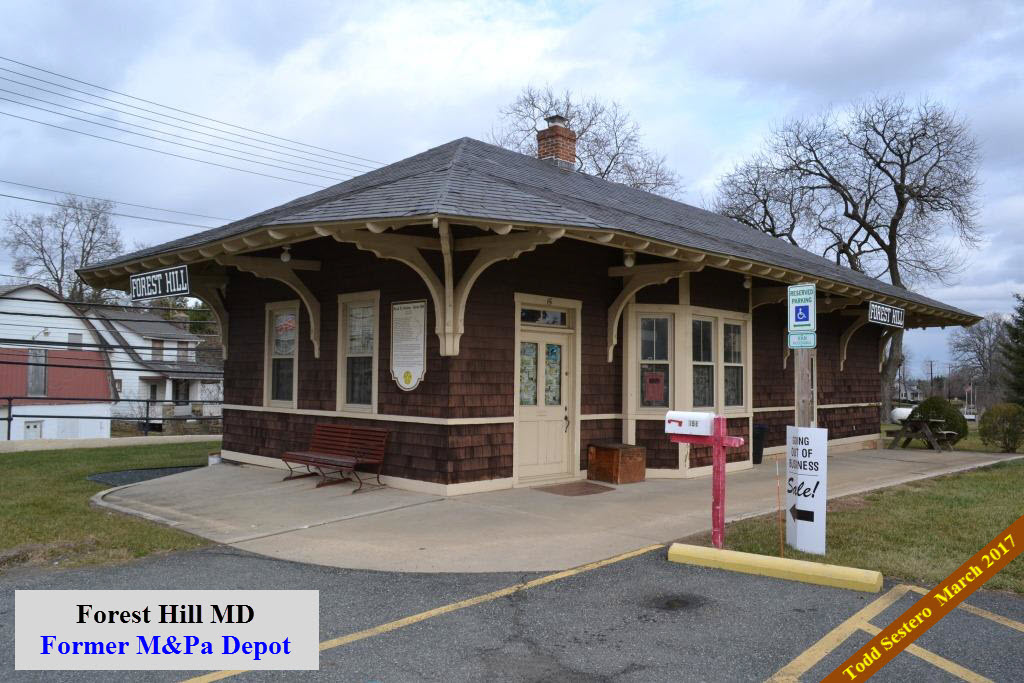

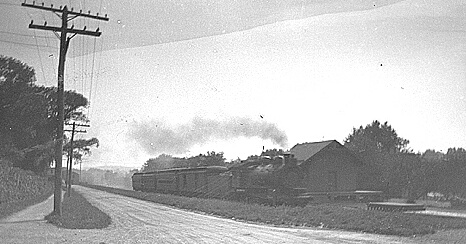 A NB Northern Central train in Lutherville MD around 1918.
A NB Northern Central train in Lutherville MD around 1918.





 From Wikipedia, Jan 2008
From Wikipedia, Jan 2008
 MP36PH-3C Cab
MP36PH-3C Cab An earlier MDot train NB on the Thomas Viaduct
An earlier MDot train NB on the Thomas Viaduct













 In downtown Baltimore
In downtown Baltimore Map showing WB&A system, including former B&A line.
Map showing WB&A system, including former B&A line. Marley Station 1944.
Marley Station 1944. Arnold Station 1945.
Arnold Station 1945.


